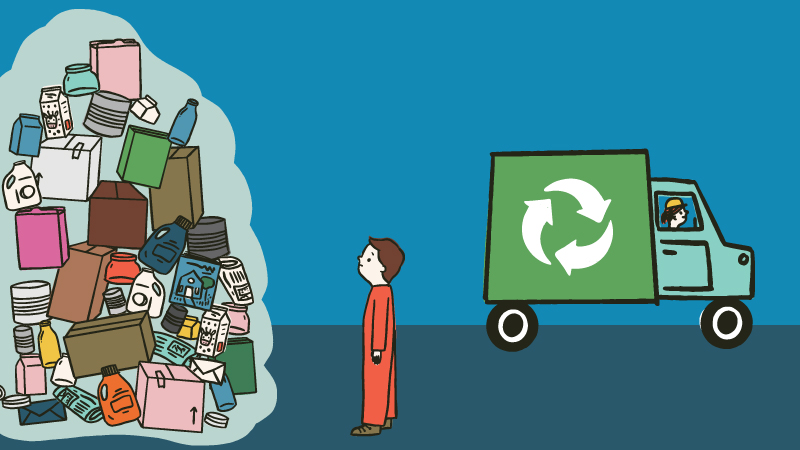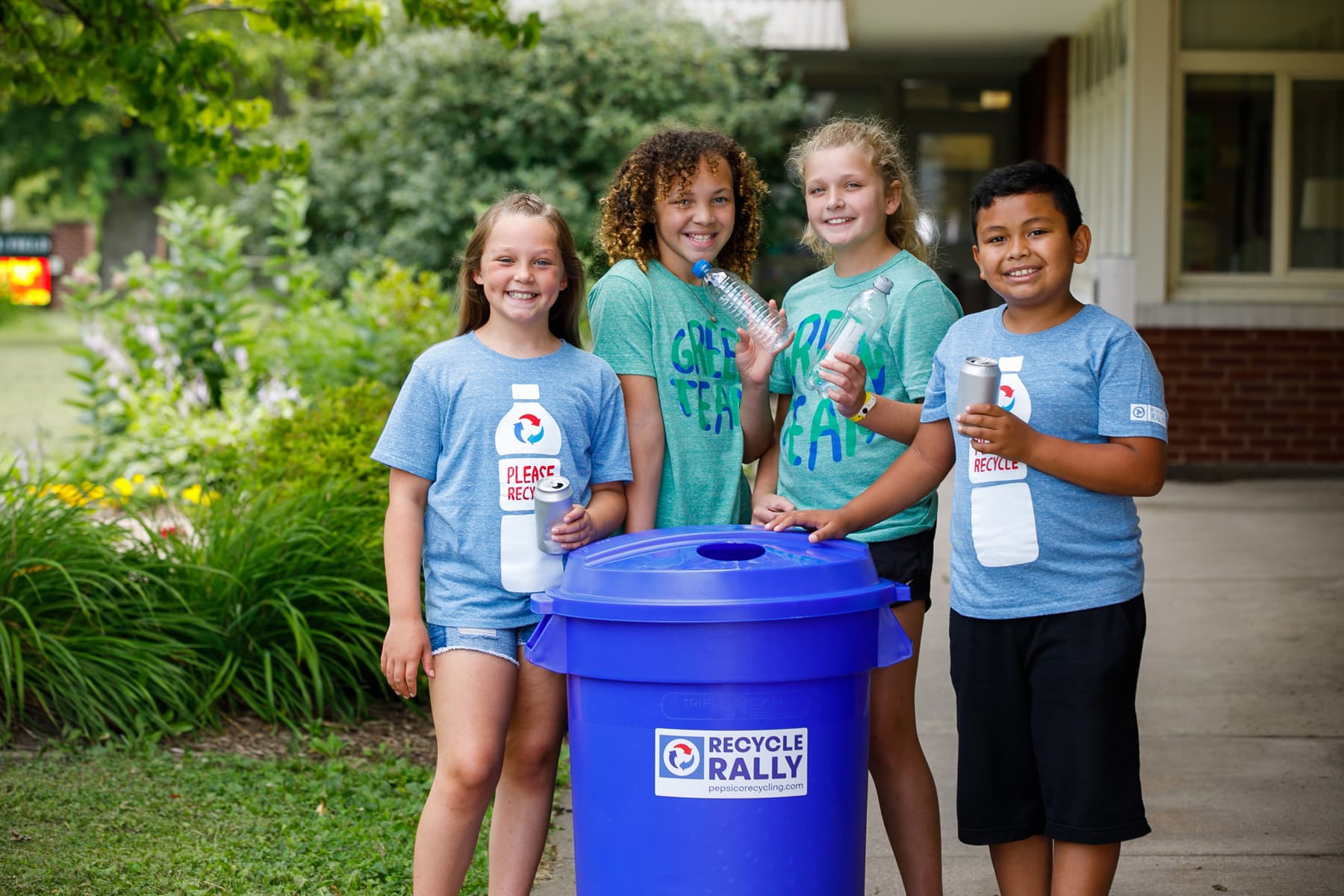Discover the History of Recycling: America Transforms Their Trash

With the advent of new materials, technology, and packaging, America quickly realized they had a trash problem! On the first Earth Day in 1970, an important moment in the history of recycling, Gary Anderson won a nationwide contest for his design of the Mobius Loop recycling logo. Unfortunately, this symbol is often misperceived on today’s packaging. When consumers see the recycling logo, they assume that it means the item can be recycled, but that isn’t always the case.

In reality, it’s meant to show what type of material the packaging is made from to provide sorting and recycling guidance. This type of confusion exists and persists throughout America’s recycling programs, and it has a negative impact on our efforts. Let’s take a look at how far we’ve come and what actions we can still take today.
Early recycling centers
After World War II, landfilling was the most popular form of disposal. Unfortunately, single-use plastics and other forms of disposable packaging began to pile up. Something had to change. Recycling had the potential to take “things out of the waste stream, preserving landfill space. So, recycling [began] to have an economic and strategic role, different from just saving the environment.”

The first recycling mill was built in 1974 in Conshohocken, Pennsylvania, but using private recycling centers was not easy. The few committed Americans who did participate had to cart everything themselves. “It wasn’t practical for the whole population, and people who were driving cars to bring stuff to recycling centers were polluting in a different way.”
Early curbside recycling programs
Dubbed “The Tree Saver,” the first recycling bin designed to collect paper, hit curbsides in Missouri in 1974. Two years later, Massachusetts secured the first-ever Environmental Protection Agency (EPA) recycling grants. This was a pivotal moment in the history of recycling. The funds allowed them to “implement weekly multi-material curbside collection programs in two cities and use the first-ever residential recycling truck.”
Around the same time, Woodbury, New Jersey city councilman Don Sanderson was inspired by a local Girl Scout troop. They “wanted to set up bins to collect recyclables (paper, cardboard, colored and clear glass, ferrous materials, and nonferrous materials) at the local ACME Market, and they needed his help.” Not only did he make it happen, but he introduced voluntary paper and cardboard pickup for the community.
The program was so well-received that he worked on making it mandatory. The city’s designated landfill neared capacity. They needed a solution. While many were hesitant to put their trash and liquor bottles out on the lawn for all their neighbors to see, Sanderson, sometimes called the “father of recycling” in America, won them over at a public meeting. The rest is history.
Curbside programs helped make recycling more convenient and increased participation. “In 1960, just over 6 percent of municipal solid waste was recycled. Since then, recycling rates have increased to about 10 percent in 1980; 16 percent in 1990; 29 percent in 2000, and over 35 percent in 2017. That’s helped decrease the amount of waste going to landfills from 94 percent in 1960 to 52 percent of the amount generated in 2017.”
How recycling trucks have changed
In an effort to expand the 1970s recycling movement, Rose Rowan introduced the idea of “recycling trailers” as an early curbside pickup option. The trailers hitched onto the backs of garbage trucks to facilitate the recycling of newspapers alongside regular domestic waste collection.

Today, things have changed dramatically. Modern technology has made curbside recycling collection more efficient than ever. Cameras in the cab, back, and sides of the truck allow drivers to check blind spots and maneuver safely. Onboard computers, usually tablets, help workers track progress, send and receive messages, and even take photos when needed.
Additionally, mechanical arms pick up bins and dump recyclables in the truck. By automating this step, workers no longer have to get on and off the truck, making their job safer, and the improved efficiency means they can make more stops.
The transformation of recycling bins
Early recycling bins were much smaller than trash cans, but now the reverse is true. As recycling gained in popularity and availability, the big blue bin made quite an entrance in America. With its bright color, distinctive shape, and the Mobius Loop emblazoned on the side, it united and served recyclers at home, work, and school — but then things became confusing.
At this point in the history of recycling, people got creative with the design. Recycling bins took on different shapes and colors, leaving people holding a fistful of used plastic scratching their heads. Is this bright yellow cylinder really for recycling? Is it just for paper? Where is my familiar blue bin? Then, the recycling rules became even murkier.
In the 1990s, in a bid to boost participation in recycling programs, environmentalists changed the game. While we had grown accustomed to sorting and separating our recyclables, they acknowledged how messy and time-consuming that could be. Suddenly, the rules changed for the beloved blue bin: “Any recyclable can go in, and then somehow, magically, it’s all separated and reused.”
The evolution from multi-stream systems
The transition from source-separated or multi-stream systems to single-stream recycling was a major moment in the history of recycling. It happened for a variety of reasons. Primarily, the time, effort, and space required to sort materials made some people reluctant to recycle.

On top of that, the increased number of separated materials became difficult to transport, as collection trucks could only have a certain number of compartments. It also meant longer, more labor-intensive pickup stops for drivers, reducing efficiency and adding costs.
Moving to single-stream recycling and allowing people to put everything into one bin streamlined the process for both households and collection workers. It also enabled the expansion of recycling programs, broadening the number of materials that could be accepted. While this may have boosted the rates of recycling, single-stream systems have created other challenges.
The technology of sortation facilities
Throughout the history of recycling in America, sorting has consistently been one of the biggest hurdles. The expectations were clear when the nation first began recycling. People sorted their recyclables. For many, this effort has become too confusing and time-consuming. Compounding the issue, most recycling bins in public spaces are now single sort.
As a result, hopeful recyclers often resort to “wish cycling.” They may be unsure whether something is being put in the correct recycling receptacle, or if it can be recycled at all, but they “wish or hope” that it’s right. This creates another layer of problems within a system that just isn’t perfect.

Single-sort recycling bins are easier for the general public. Unfortunately, it takes a lot of time, effort, and money to separate things correctly. In the meantime, this commingling can cause contamination among the recyclables, rendering entire batches unusable. When that’s the end result, is it even worth it? If we want to recycle effectively, we need to improve the system.
For a large part of our recycling history, we’ve exported our recycled materials. Today, we are trying to handle more and more of this process domestically. When we first started sorting, the process was mostly manual and involved workers watching items bounce around on conveyors. Technology has improved throughout the history of recycling, though, and cool technologies like optical sorters have modernized sorting, boosting our efforts.
As the name suggests, these machines work by identifying and sorting recyclable materials on a conveyor belt. Through automation, this process can be done affordably and efficiently at remarkable speeds. Of course, some limitations remain. For example, sorting facilities do not have limitless storage space, meaning only a finite number of materials can be targeted.
Local and state-level policy measures
While their prevalence varies from city to city, curbside programs have made recycling more practical. One major hurdle, however, is that recycling rules and guidelines are not always consistent. In its National Framework for Advancing the U.S. Recycling System, the EPA identified three key challenges, including inconsistent messaging on how to recycle due to localized differences.
Indeed, people in the same metropolitan area could have vastly different experiences with recycling. Neighbors may not have to follow the same set of rules because communities operate independently. Additionally, container deposit laws or “bottle bills” vary from one state to another. This type of legislation is “a proven, sustainable method of capturing beverage bottles and cans for recycling. The refund value of the container (usually 5 or 10 cents) provides a monetary incentive to return the container for recycling.”
Meanwhile, in other parts of the world, recycling is handled more uniformly and proactively. Entire countries recycle using the same clear guidelines and convenient options. This helps eliminate confusion while encouraging participation in important waste reduction efforts.
Change is coming
According to the World Economic Forum, investing in a circular economy could provide as much as $4.5 trillion in economic benefits by 2030. Currently, though, just 8.6% of our world follows the crucial reduce, reuse, recycle model. Making the transition requires everyone to work together, and fortunately, there are some solutions on the way.

In addition to new technology such as optical sorters, there has also been a renewed interest in environmentally responsible practices from corporations and consumers. In response to this shift, we’re seeing more and more companies setting goals to reduce waste and manufacture new products from recycled materials.
Additionally, Extended Producer Responsibility (EPR)—regulatory action that makes producers of waste responsible for its management—is getting a closer look. In other countries, such policies have been successful, and there are many benefits when it works well. In the United States, major players such as Waste Management (WM) have shown support for well-written legislation that addresses these specific concerns.
More than ever, we’re also seeing private citizens, businesses, and even schools working towards a zero-waste model. Incorporating these practices into general society will require a significant culture shift. The good news is that there are promising signs that we’re increasingly ready. In this information age, we’re able to communicate more effectively. We can develop strategies to build facilities and create jobs within this much-needed sector.
Let’s work together to pave the way to a more sustainable future.
Want to get kids thinking about sustainability, here’s a free Create Your Own History of Recycling Presentation
Learn More

Recycle Rally
Recycle Rally is a free K-12 program that provides rewards and tools to help enhance recycling at your school!
Explore now
Additional Resources
Our comprehensive library of resources was designed to inspire the next generation of green leaders.
Explore now

